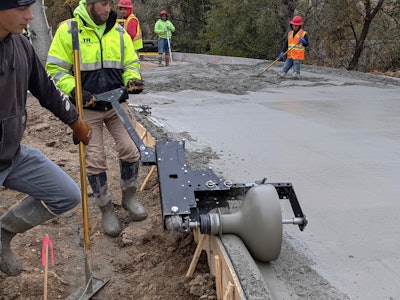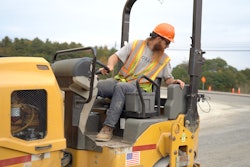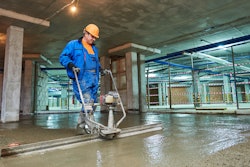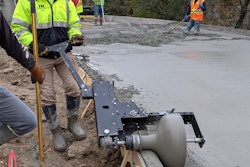
Labor shortages. High demand. Tight budgets. Contractors are facing more challenges every day. To overcome these obstacles while improving profits, contractors need equipment that can help them expand their capabilities for increased flexibility and efficiency. Thankfully, concrete equipment has evolved to provide portable, operator-friendly solutions to help broaden contractors’ in-house capabilities.
Concrete work that once required a lengthy, back-breaking process or waiting on a subcontractor can now be done quickly and efficiently with a contractor’s own crew if they invest in a few pieces of equipment. Here are the features and benefits of the concrete equipment that makes it possible.
Roll Your Curb and Gutter into Shape
Traditionally, curb and gutter work has been performed through a slow, physically demanding manual process or by expensive slipform pavers run by highly-skilled operators. Walk-behind curbing machines, however, have emerged as an innovative solution for crews to self-perform curb and gutter projects, minimizing outside costs while reducing labor needs.
Curb rolling machines are designed with a handle attached to a spinning metal drum that is connected to a power source. The compact design makes it easy for crews to move the equipment from job to job, streamlining transportation when completing curb and gutter work in several different locations throughout the day.
While these machines are often powered by a hydraulic power source, more recent entries on the market operate with a removable and rechargeable 60-volt lithium-ion battery commonly found in other tools. These battery-powered curbing machines are often used for monolithic pours but can also be used for patch and repair work and can complement slipform pavers for corners and tight radii involved with larger jobs.
With a single-operator curbing machine, crews can complete curb and gutter work up to twice as fast as with manual methods, pouring and finishing up to 2,000 feet in a single day. The ergonomic design allows it to be operated in an upright position, increasing safety for the crew and reducing physical strain and fatigue. The equipment is intuitive to use, making it easy to learn and produce consistent results, even for users who are less experienced in concrete work.
Walk-behind curbing machines can be used with pre-designed drum profiles as well as custom drum options to meet a project’s specifications. Contractors should look for equipment that has controls on the handles for variable speed and direction to give the operator ultimate control and safety.
This same technology that brings portability, safety, and efficiency to curb and gutter work can also be found in screeds to provide a smooth, level finish for concrete flatwork including sidewalks, streets or parking lots.
 Many contractors take advantage of battery-powered roller screeds that give crews more mobility when moving between projects.Curb Roller Manufacturing
Many contractors take advantage of battery-powered roller screeds that give crews more mobility when moving between projects.Curb Roller Manufacturing
Make Fast Work of Flatwork
Like walk-behind curb rolling machines, roller screeds are known for their portability, ergonomic design, ease of use, and ability to create quality results with less dependence on the operator’s skill level. The equipment consists of a detachable pipe that is connected to a drive head with an extended handle. Roller screeds move concrete with a spinning motion, contrasting other methods that use only vibration or require sheer force by the operator. This rolling action improves the integration of aggregate throughout the pour, ensuring a flatter finished product that avoids too much cream being pulled to the surface, which can compromise the finished results.
While multiple power source options are available, many contractors take advantage of battery-powered roller screeds that give crews more mobility when moving between projects. These screeds remove the hassle of worrying about a cord or an engine's added weight, and allow contractors to actively protect the environment and work safely indoors by operating without fumes. Some battery-powered roller screeds can screed off up to 1,800-2,500 square feet with one fully charged battery, depending on the slump and pipe length.
For better efficiency, contractors can also pair a roller screed with a modular pipe system. With these versatile systems, crews can accommodate pours ranging from 3 to 22 feet wide with one set of connectable pipes instead of purchasing dedicated pipe lengths for different pours. The equipment has minimal storage requirements and is a breeze to transport — crews can simply disconnect the pipe sections, place them in the back of a pickup truck and drive to the next location.
 With a single-operator curbing machine, crews can complete curb and gutter work up to twice as fast as with manual methods, pouring and finishing up to 2,000 feet in a single day.Curb Roller Manufacturing
With a single-operator curbing machine, crews can complete curb and gutter work up to twice as fast as with manual methods, pouring and finishing up to 2,000 feet in a single day.Curb Roller Manufacturing
Turn a Bigger Profit
Investing in innovative concrete equipment can quickly pay for itself by helping to increase quality while boosting workforce efficiency and reducing injuries and operator fatigue. Walk-behind curbing machines can cut labor on projects by up to 75% and can pay for themselves in as little as 1,500 linear feet. Meanwhile, by pairing a battery-powered roller screed with a modular pipe system, contractors can see savings that offset the cost in only a matter of weeks.
When purchasing concrete equipment, contractors should also look to work with a manufacturer that provides training, expertise and ongoing customer support so they can maximize their investment. With minimal training time, some manufacturers can help crews quickly learn to operate the equipment and produce consistent, quality results with minimal supervision. Some concrete equipment manufacturers can also provide valuable insight by sharing their experience and expertise in the concrete field.
New advancements in concrete equipment have created convenient solutions for the many challenges contractors face. Walk-behind curbing machines and roller screeds have taken the physical strain, outside expense, and long wait times out of concrete work. With an investment in equipment that is simple to learn and convenient to use, crews can produce their own high-quality results safely and efficiently in-house.



















